This post may contain affiliate links. Please read our disclosure policy.
This single serving Kung Pao Chicken is a quick and flavorful stir-fry made with tender chicken, crunchy peanuts, crisp bell peppers, and a bold, spicy-sweet sauce. Ready in just 15 minutes, it’s perfect for a fast and satisfying meal.
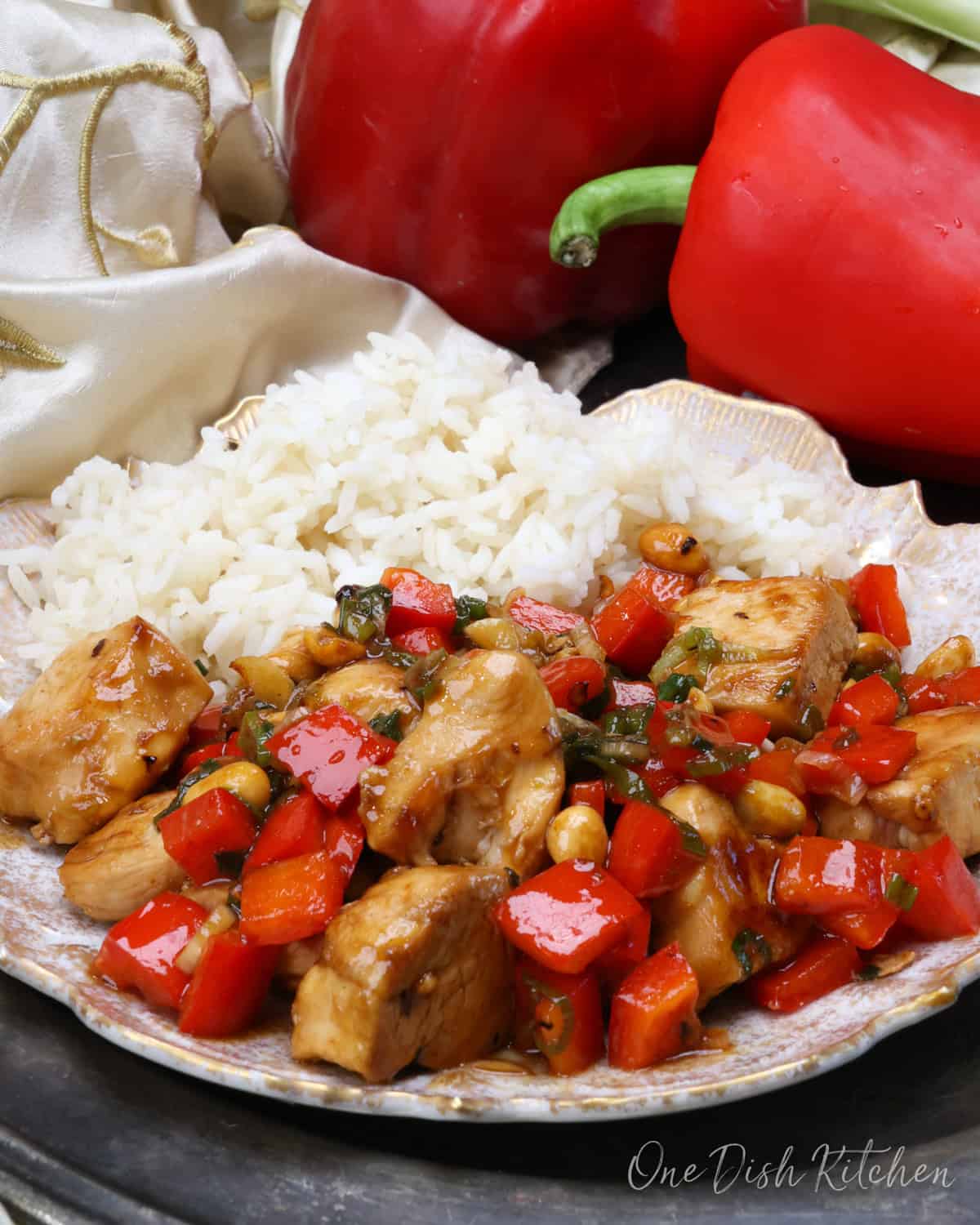
Featured Comment
“This was really easy and very good! Highly recommend this recipe!”
– lobrien26
Why You’ll Love This Recipe
- Quick & Easy: Ready in just 15 minutes.
- Big Flavor: Bold, savory, and slightly spicy.
- Customizable: Adjust spice, sauce, and ingredients.
- Fresh & Nutritious: Made with lean chicken, bell peppers, and peanuts.
- Perfectly Portioned: One satisfying serving with no leftovers.
- Takeout at Home: Enjoy restaurant-style flavor without the wait.
What I love most about this Kung Pao Chicken is how it brings bold, exciting flavor to the table in such a short amount of time. In just 15 minutes, I can enjoy a dish that tastes like it came straight from my favorite Chinese restaurant, but even better because I made it myself. The chicken is tender, the vegetables stay crisp, and that sauce, rich, spicy, and just a little sweet, ties everything together beautifully.
This recipe is inspired by the classic Sichuan-style dish, and it delivers all the flavor without being complicated. If you want to share it, just double the ingredients and you’ve got dinner for two.
Explore more single serving Asian-inspired recipes like pepper steak for one, stir-fry beef and broccoli for one, single serve Mongolian beef, and shrimp fried rice for one.

Ingredients And Substitutions
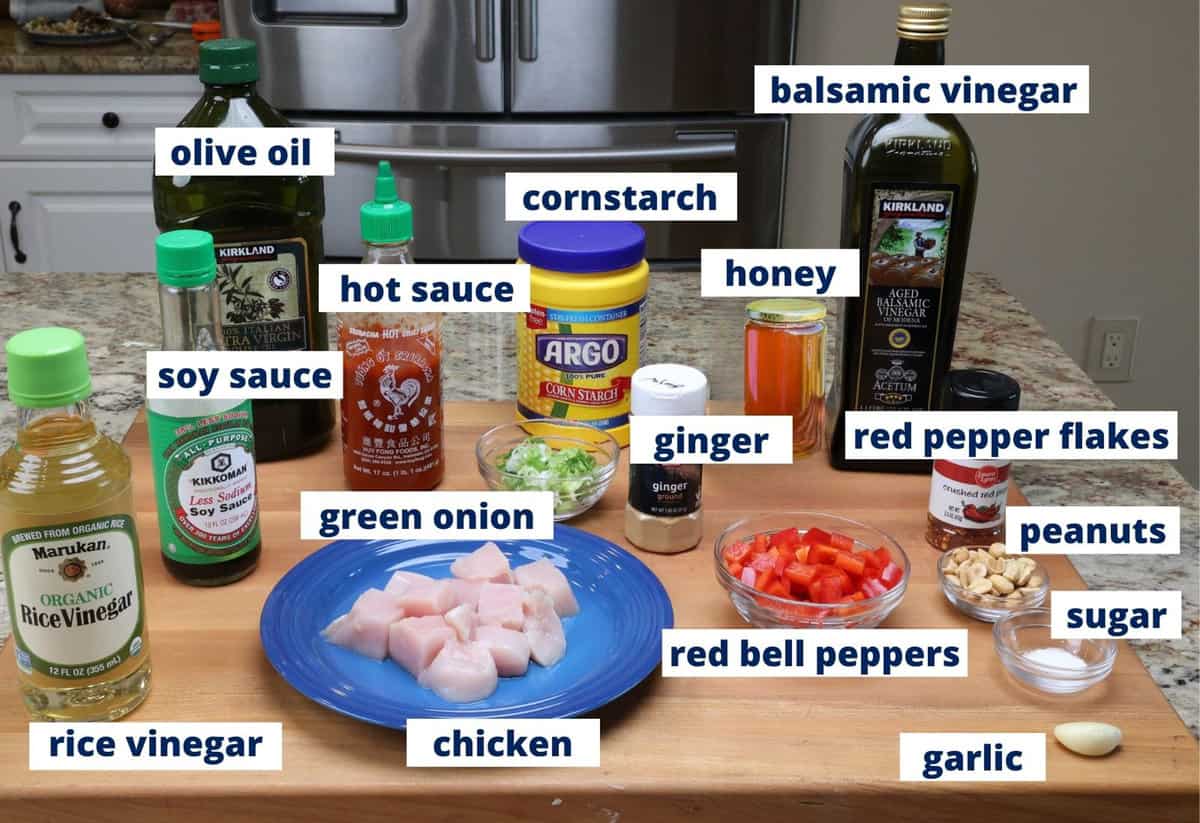
If you have any ingredients leftover from this small batch Kung Pao Chicken recipe, check out our Leftover Ingredients Recipe Finder.
- Rice Vinegar: A mild vinegar with a slightly sweet flavor. If needed, substitute with white vinegar or apple cider vinegar.
- Low Sodium Soy Sauce: Adds salty, umami depth. Use tamari for a gluten-free option.
- Sugar: Balances the acidity of the vinegar and adds sweetness. For a low-carb option, substitute with stevia or monk fruit.
- Cornstarch: Thickens the sauce. Arrowroot powder works as an alternative.
- Chicken Breast: The protein base of the dish. A boneless, skinless chicken thigh works just as well. Extra chicken breasts? Try them in chicken paprika for one, chicken fajitas for one, or single serving jerk chicken.
- Honey: Brings natural sweetness. Maple syrup is a good alternative.
- Balsamic Vinegar: Adds a slightly sweet, tangy depth. Swap with red wine vinegar or apple cider vinegar if needed.
- Sriracha: Brings heat and a touch of acidity. For a milder option, use a different hot sauce or leave it out.
- Ginger: Provides warmth and depth. Use freshly grated or ground ginger.
- Olive oil: Used for cooking the chicken. Avocado or vegetable oil also work.
- Peanuts: Add crunch and nuttiness. If you have a peanut allergy, swap with cashews, almonds, or omit them.
- Red Pepper Flakes: Adjust for heat preference. Leave out for a milder dish.
- Bell Pepper: Adds color and a crisp, slightly sweet texture. I prefer red bell pepper, but any color works. For a different vegetable, try zucchini or snap peas. Use leftover bell pepper in single serving lo mein, small batch stuffed peppers, or crab cakes for one.
- Green Onion: Both the white and green parts add flavor. If unavailable, substitute with chives or shallots.
- Garlic: Enhances the dish with robust, aromatic flavor. Use less or swap with garlic powder for a milder taste.
Recipe Variations
Add your own twist to this dish with these simple variations:
- Kung Pao Cauliflower: Swap the chicken for cauliflower florets. Roast or blanch them before stir-frying for a delicious vegetarian option.
- Lettuce Wraps: Serve the chicken in crisp lettuce leaves. Top with crushed peanuts and an extra drizzle of sauce for a fresh, low-carb meal.
- Chicken Sliders: Pile Kung Pao Chicken onto slider buns and add homemade coleslaw or shredded cabbage for a flavorful appetizer or snack.
How To Make Kung Pao Chicken
These step-by-step photos and instructions help you visualize how to make a single serving of kung pao chicken. See the recipe below for ingredient amounts and full recipe instructions.
- Prepare the Marinade: In a medium-sized bowl, mix rice vinegar, soy sauce, sugar, and cornstarch. Add the chicken pieces, ensuring they’re well coated. Set aside.
- Mix the Sauce: In a different small bowl, blend soy sauce, honey, balsamic vinegar, sriracha, water, cornstarch, and ginger. Keep this mixture aside for later.
- Cook Peanuts and Red Pepper Flakes: Place a 10-inch skillet over medium-high heat and add 1/2 tablespoon of olive oil. Swirl to coat the bottom of the skillet. Add the peanuts and red pepper flakes and cook, stirring frequently, for about 1-2 minutes or until the peanuts are lightly browned. Transfer them to a bowl and set aside.
- Cook Bell Pepper and Garlic: Add the remaining 1/2 tablespoon of oil to the skillet. Once hot, add the bell pepper and garlic. Stir-fry for about 1 minute, then transfer to the bowl with the peanuts.
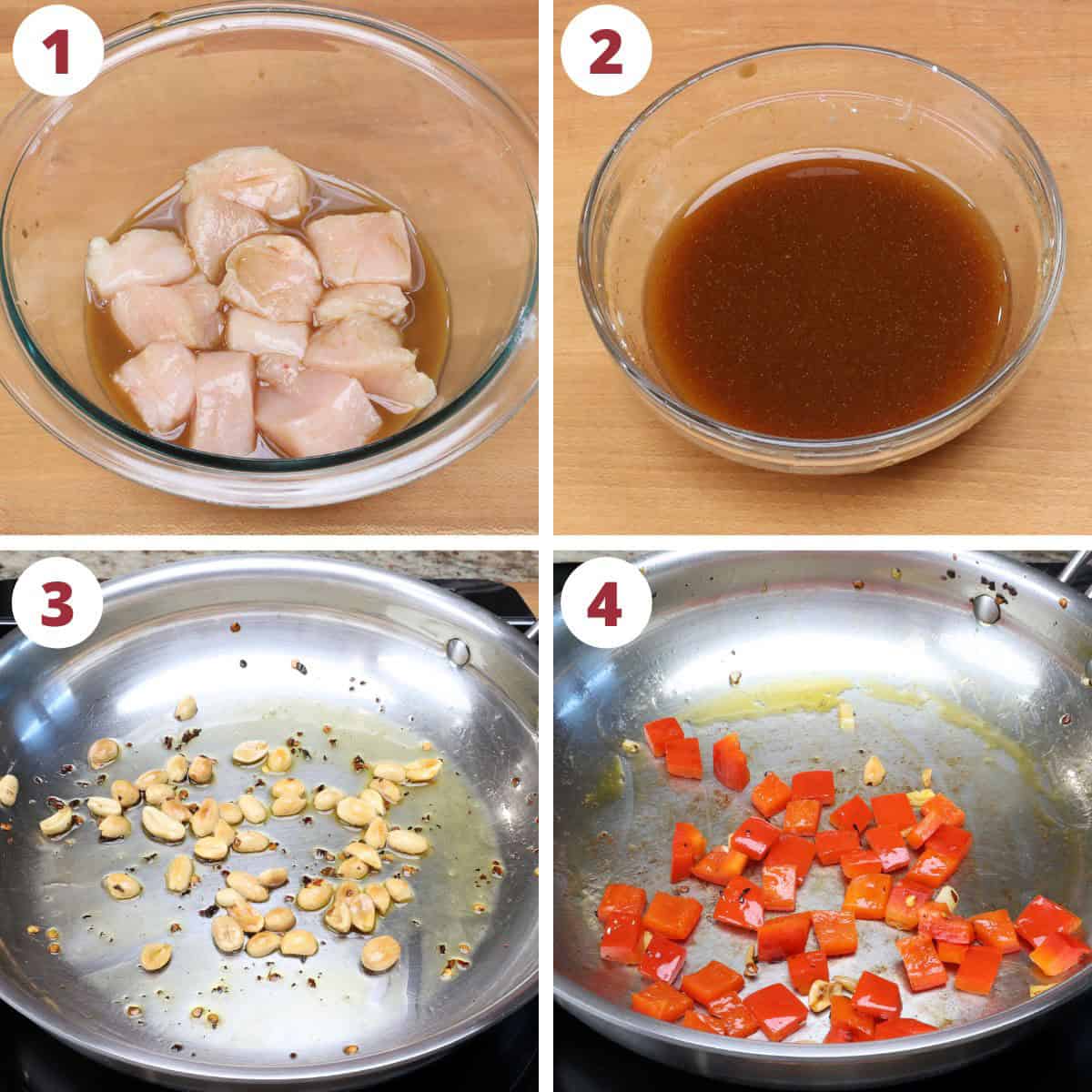
- Cook the Chicken: If the pan appears dry, add an extra half tablespoon of olive oil. Add the marinated chicken to the skillet, discarding any leftover marinade. Cook for 1-2 minutes per side until fully cooked.
- Add Green Onions: Shift the chicken to the skillet’s edges, then toss in the green onions. Sauté them briefly, stirring often.
- Combine Everything: Bring back the set-aside peanuts, vegetables, and the kung pao sauce into the pan with the chicken and green onions.
- Final Touch: Lower the heat to a simmer and cook until the sauce thickens and all ingredients are well incorporated, roughly 30 seconds.
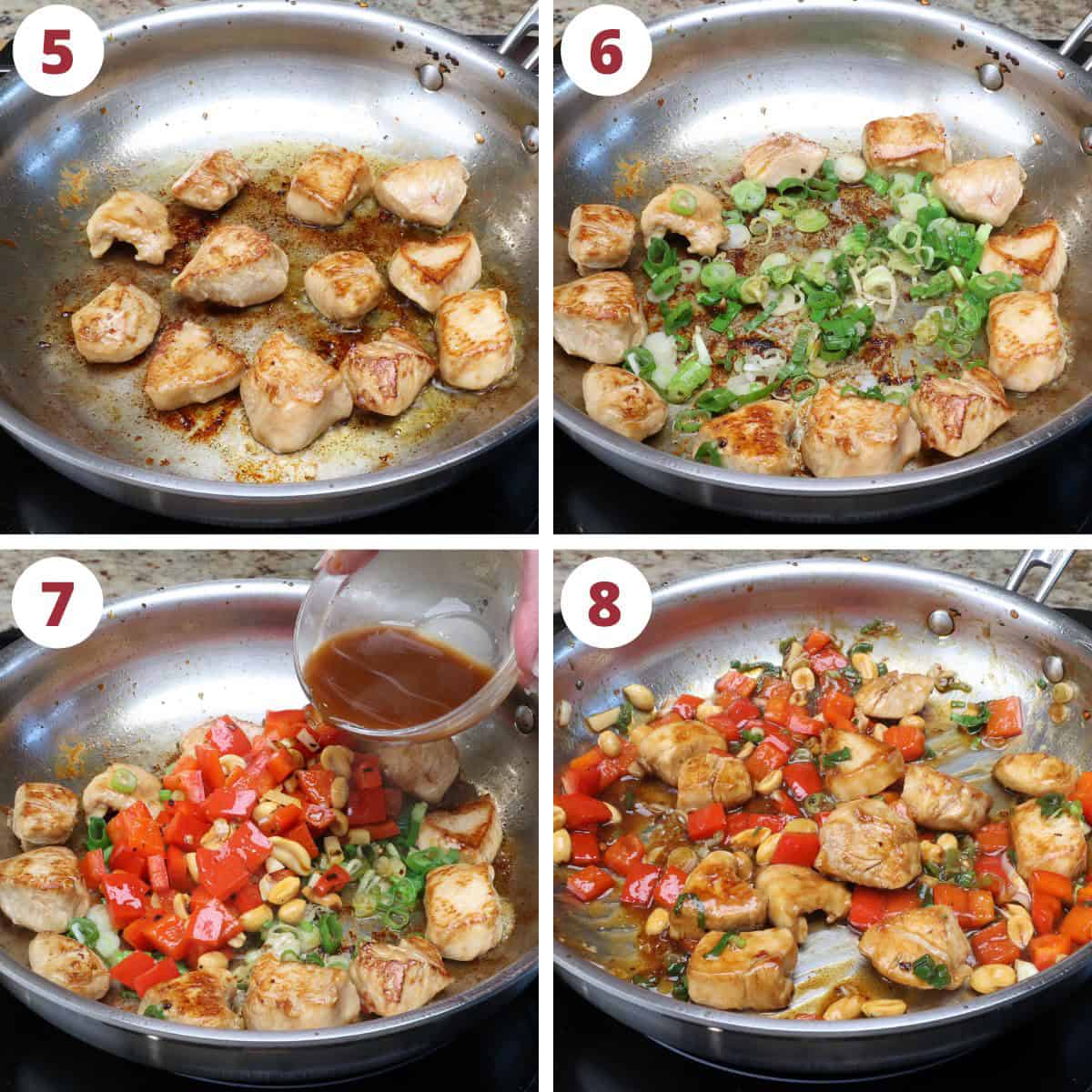
Serve over a bed of cooked rice.
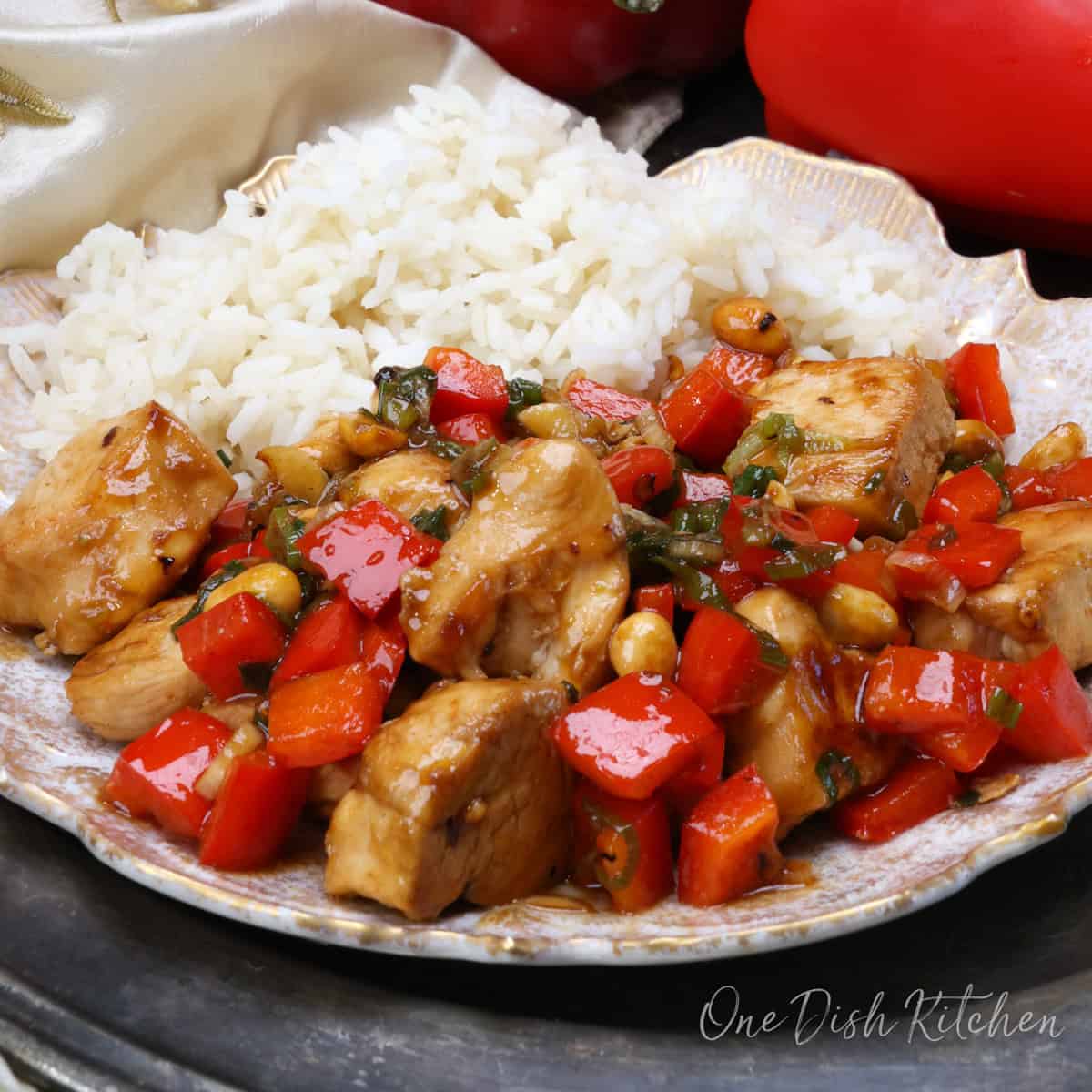
Expert Tips
- Read First: Review the full recipe and Ingredient Notes before starting.
- Prep Ahead: Chop the chicken, slice the vegetables, and measure sauce ingredients before cooking.
- Avoid Overcrowding: Stir-fry in batches if needed to keep ingredients crisp. A 10-inch skillet works well.
- Control the Heat: Skip the sriracha for mild flavor or add more for extra spice.
- Watch the Pork: Cook just until no longer pink. It will finish cooking when combined with the sauce.
- Taste the Sauce: Adjust to your liking – add soy sauce for salt, honey for sweetness, vinegar for tang, or sriracha for heat.
Serving Suggestions
Pair this Kung Pao Chicken with a simple single serving side dish to complete your meal.
- Rice: A classic choice that balances the spiciness and soaks up the flavorful sauce. Use baked white rice for one or small batch of baked brown rice.
- Fried Rice: Add extra flavor by serving with homemade fried rice for one for a hearty, satisfying combo.
- Stir-Fried Vegetables: A side of broccoli, carrots, snow peas, or bok choy adds freshness and crunch.
- Noodles: Serve over egg noodles or rice noodles for a different take that absorbs the sauce perfectly.
Frequently Asked Questions
Yes, you can! While chicken is traditional, you can substitute it with shrimp, beef, tofu, or even a combination of these proteins for variety.
Store leftovers in an airtight container in the refrigerator for up to 3-4 days. Reheat in a pan or microwave until piping hot before serving.
Ways To Use Leftover Ingredients
If you have any ingredients leftover from this recipe, check out our Leftover Ingredients Recipe Finder or you might like to consider using them in any of these single serving and small batch recipes:
If you’ve made this easy kung pao chicken recipe, I’d love to hear how it turned out for you. Please rate the recipe and share your thoughts in the comments below.
Snapped a photo? Tag us on Instagram; we’d be thrilled to see your creation!
Kung Pao Chicken For One
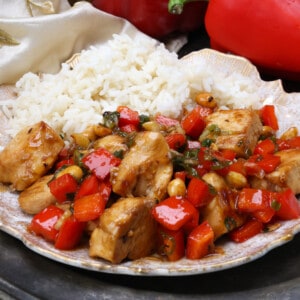
Equipment
Ingredients
For the Marinade
- 2 teaspoons rice vinegar
- 2 teaspoons low sodium soy sauce
- ½ teaspoon granulated sugar
- ½ teaspoon cornstarch
- 1 (4 to 6-ounce) boneless, skinless chicken breast or thigh, cut into 1-inch cubed pieces
For the Sauce
- 1 tablespoon low sodium soy sauce
- 2 teaspoons honey
- 1 teaspoon balsamic vinegar
- ¼ teaspoon sriracha or another type of hot sauce
- ½ tablespoon water
- ⅛ teaspoon ground ginger or ¼ teaspoon of fresh peeled and grated ginger.
- ½ teaspoon cornstarch
For the Main Dish
- 1 tablespoon olive oil -divided
- 2 tablespoons whole roasted unsalted peanuts or 3 tablespoons roasted unsalted cashews
- ¼ teaspoon crushed red pepper flakes
- ½ cup chopped red bell pepper
- 1 green onion -white and green parts chopped
- 1 clove garlic -minced
To Serve
- 1 cup cooked white rice -optional. This dish can also be enjoyed without rice, over rice noodles or egg noodles.
Instructions
Make the Marinade
- In a medium bowl, whisk together the rice vinegar, soy sauce, sugar, and cornstarch.Add the chicken pieces, stirring to coat them evenly. Set aside while you prepare the sauce.
Make the Sauce
- In a small bowl, combine the soy sauce, honey, balsamic vinegar, sriracha, water, ginger, and cornstarch. Stir until smooth and set aside.
Cook the Main Dish
- Heat ½ tablespoon of olive oil in a 10-inch skillet over medium-high heat. Add the peanuts and red pepper flakes, stirring until the peanuts turn lightly golden. Transfer them to a bowl and set aside.
- Add another ½ tablespoon of olive oil to the skillet. Once hot, add the bell pepper and garlic, stirring for about 1 minute. Transfer them to the bowl with the peanuts.
- If the skillet looks dry, add ½ tablespoon of oil. Add the marinated chicken, discarding any leftover marinade. Cook for 1-2 minutes per side until fully cooked.
- Push the chicken to the edges of the skillet and add the green onions. Stir-fry for about 30 seconds.
- Return the peanuts, vegetables, and sauce to the skillet.
- Reduce the heat to low and let the sauce thicken for about 30 seconds, stirring to coat everything evenly.
- Serve the Kung Pao Chicken on its own or over steamed rice.
Notes
- Read First: Review the full recipe and Ingredient Notes before starting.
- Prep Ahead: Chop the chicken, slice the vegetables, and measure sauce ingredients before cooking.
- Avoid Overcrowding: Stir-fry in batches if needed to keep ingredients crisp. A 10-inch skillet works well.
- Control the Heat: Skip the sriracha for mild flavor or add more for extra spice.
- Watch the Pork: Cook just until no longer pink. It will finish cooking when combined with the sauce.
- Taste the Sauce: Adjust to your liking, add soy sauce for salt, honey for sweetness, vinegar for tang, or sriracha for heat.
Nutrition
The information shown is an estimate provided by an online nutrition calculator. It should not be considered a substitute for a professional nutritionist’s advice.
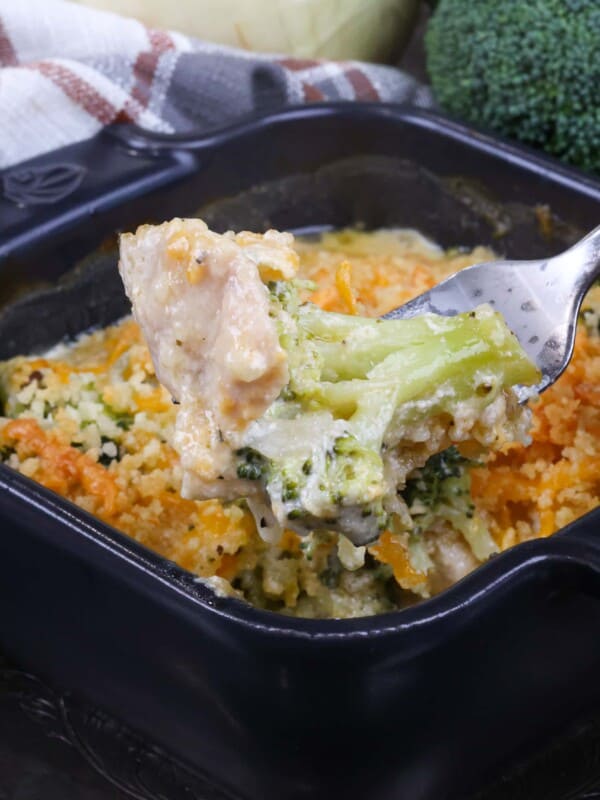
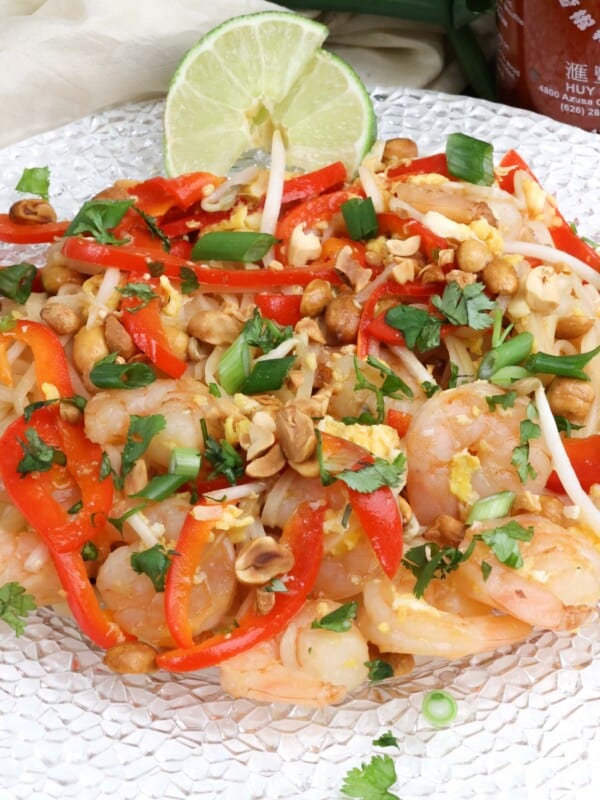
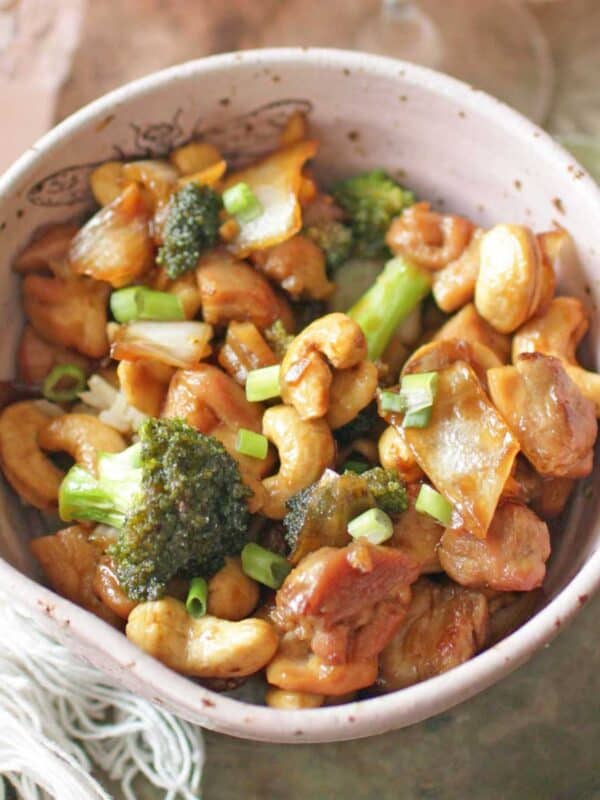
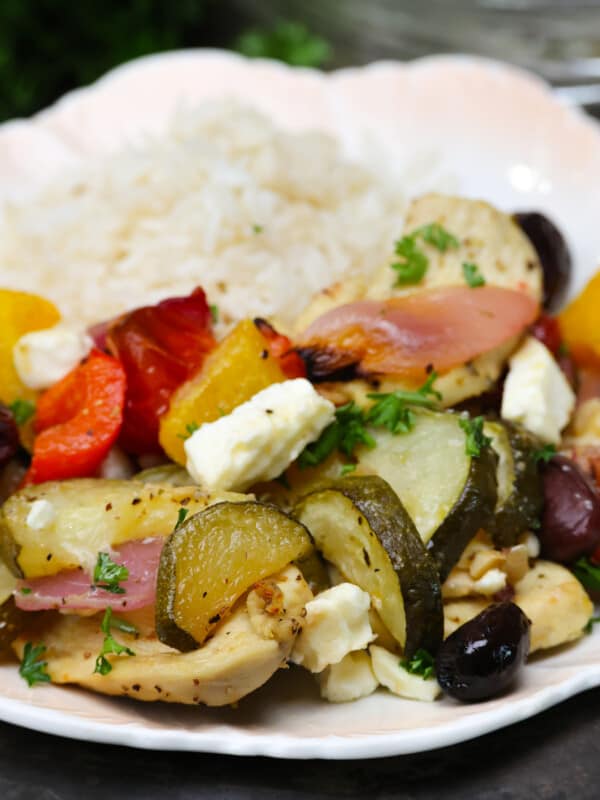


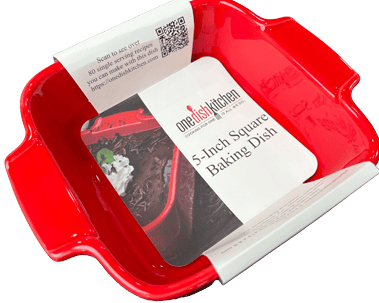








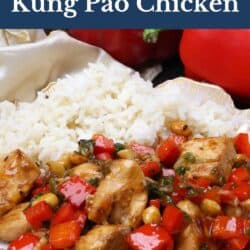

Made it with pork. Added more peppers and doubled the sauce. It was delicious!
This was really easy and very good! Highly recommend this recipe!
Great! Made this the other day. Even had the peanuts on hand! Shared with several ‘singles’ to encourage them to expand their repertoire! (instead of ‘eating out’)
I’m so happy you enjoyed the recipe and thank you for sharing!
I really enjoyed this and made it with shishito peppers on the side 🙂 Super tasty and will be one I go back to for a quicker week night meal.
. . .took me a little longer than 15 minutes, but I doubled the recipe so I would have it for tomorrow!!
This and an eggroll made a perfect early dinner this evening.
I made this tonight, I did not use peanuts, but followed recipe has listed, really enjoyed it !!
Thank you 🙂
I’m so happy you enjoyed it!
Another great recipe made even easier when I found the “cook mode” tab!
Thank you! Isn’t that a great feature? We’re so happy to be able to offer it on our website.
Hope you make a second cookbook with all these recipes not in the first one. Very hard to keep track of th new ones.
Use first one very often and enjoy.
Another delicious ODK recipe! So easy to make with ingredients I had on hand already. Thanks!
I’m so happy you enjoyed it!
Good recipe.
Thank you.